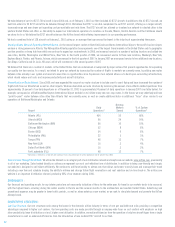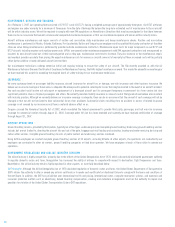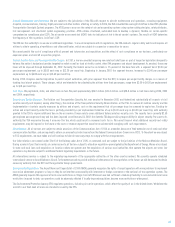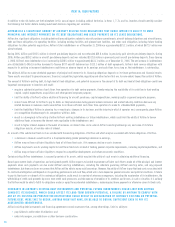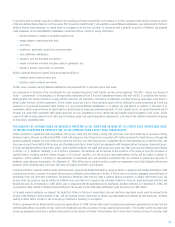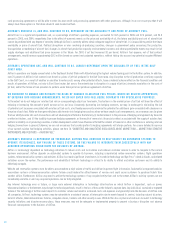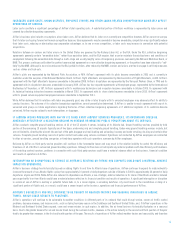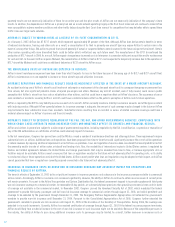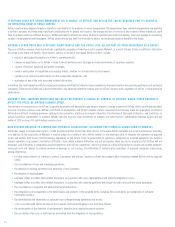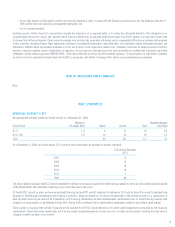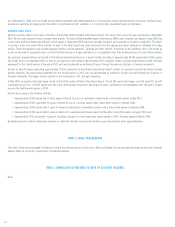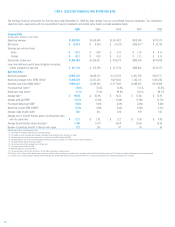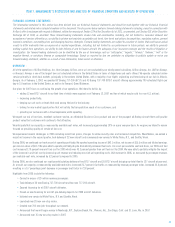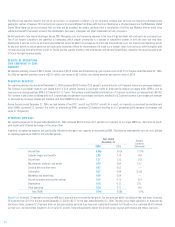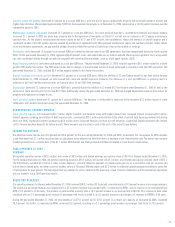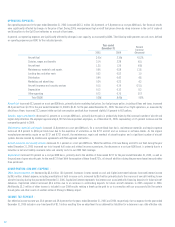Airtran 2006 Annual Report Download - page 18
Download and view the complete annual report
Please find page 18 of the 2006 Airtran annual report below. You can navigate through the pages in the report by either clicking on the pages listed below, or by using the keyword search tool below to find specific information within the annual report.
quarterly results are not necessarily indicative of those for an entire year and the prior results of AirTran are not necessarily indicative of the company’s future
results. In addition, the dependence of AirTran on a primary hub and on a route network operating largely on the East Coast make and will continue to make AirTran
more susceptible to adverse weather conditions and other traffic delays along the East Coast than some of its competitors that may be better able to spread these
traffic risks over larger route networks.
AIRTRAN IS SUBJECT TO VARIOUS RISKS AS A RESULT OF ITS FLEET CONCENTRATION IN B717S.
As of January 1, 2007, AirTran has 87 B717 aircraft, which represent approximately 69 percent of the fleet. Although AirTran does derive certain benefits in terms
of reduced maintenance, training and other costs as a result, a concentration of its fleet in primarily one aircraft type may expose AirTran to certain risks in the
event of, among other things, FAA action to ground that aircraft generally if actual or suspected defects were discovered in the future unique to that aircraft. Certain
other carriers operating with more diversified fleets could be better able to withstand any such future event. The manufacturer of the B717 discontinued the
production of B717 aircraft in 2006. As a result, AirTran expects to experience increased costs in later years in connection with parts acquisition and/or maintenance
for such aircraft. In the event AirTran acquires Midwest, the concentration of AirTran’s fleet in B717 can be expected to temporarily increase due to the operation of
B717 aircraft by Midwest until such time as additional deliveries of B737 aircraft to AirTran occur.
THE MAINTENANCE COSTS OF AIRTRAN ARE EXPECTED TO INCREASE.
AirTran’s recent maintenance expenses have been lower than what it expects to incur in the future because of the young age of its B717 and B737 aircraft fleet.
AirTran’s maintenance costs are expected to increase as these aircraft age and utilization increases.
AIRTRAN’S REPUTATION AND FINANCIAL RESULTS COULD BE NEGATIVELY AFFECTED IN THE EVENT OF A MAJOR AIRCRAFT ACCIDENT.
An accident involving one of AirTran’s aircraft could involve not only repair or replacement of the damaged aircraft and its consequent temporary or permanent loss
from service, but also significant potential claims of injured passengers and others. Moreover, any aircraft accident, even if fully insured, could cause a public
perception that AirTran’s aircraft are less safe or reliable than other airlines, and that could have a negative effect on AirTran’s business. The occurrence of one or
more incidents or accidents involving AirTran’s aircraft could have a material adverse effect on the public’s perception of AirTran and its future operations.
AirTran is required by the DOT to carry liability insurance on each of its aircraft. AirTran currently maintains liability insurance in amounts and of the type consistent
with industry practice. Although AirTran currently believes its insurance coverage is adequate, the amount of such coverage may be changed in the future or AirTran
may be forced to bear substantial losses from accidents. Substantial claims resulting from an accident in excess of related insurance coverage could have a
material adverse impact on AirTran’s business and financial results.
AIRTRAN IS SUBJECT TO EXTENSIVE REGULATION BY THE FAA, THE DOT, AND OTHER GOVERNMENTAL AGENCIES, COMPLIANCE WITH
WHICH COULD CAUSE AIRTRAN TO INCUR INCREASED COSTS AND NEGATIVELY AFFECT ITS BUSINESS AND FINANCIAL RESULTS.
AirTran and airlines in general are subject to a wide range of governmental regulation, including regulation by the FAA. A modification, suspension or revocation of
any of the FAA authorizations or certificates of AirTran could adversely impact its business.
In the last several years, Congress has passed laws and the FAA has issued a number of maintenance directives and other regulations. These requirements impose
substantial costs on airlines. Additional laws and regulations have been proposed from time to time that could significantly increase the cost of airline operations
or reduce revenues by imposing additional requirements or restrictions on operations. Laws and regulations have also been considered that would prohibit or restrict
the ownership and/or transfer of airline routes or takeoff and landing slots. Also, the availability of international routes to United States carriers is regulated by
treaties and related agreements between the United States and foreign governments that may be amended from time to time, or because appropriate slots or
facilities may not be available. AirTran cannot assure you that laws or regulations enacted in the future will not adversely affect its operating costs, or its ability
to conduct existing or future operations outside of the United States. AirTran cannot predict what laws and regulations may be adopted or their impact, and AirTran
cannot guarantee that laws or regulations currently proposed or enacted in the future will not adversely affect it.
INCREASES IN INSURANCE COSTS OR REDUCTION IN INSURANCE COVERAGE MAY ADVERSELY IMPACT THE OPERATIONS AND
FINANCIAL RESULTS OF AIRTRAN.
The terrorist attacks of September 11, 2001 led to a significant increase in insurance premiums and a decrease in the insurance coverage available to commercial
airline carriers. Accordingly, AirTran’s insurance costs increased significantly. Likewise, the ability of AirTran to continue to obtain insurance even at current prices
will remain uncertain. Pursuant to the Airline Transportation and System Stabilization Act, the federal government stepped in to provide supplemental third-party
war-risk insurance coverage to commercial carriers for renewable 60-day periods, at substantially lower premiums than prevailing commercial rates and for levels
of coverage not available in the commercial market. In November 2002, Congress passed the Homeland Security Act of 2002, which mandated the federal
government to provide third-party, passenger, and hull war-risk insurance coverage to commercial carriers through August 31, 2003, and which permitted such
coverage to be extended by the government through December 31, 2003. The Emergency Wartime Supplemental Appropriations Act extended the government’s
mandate to provide war-risk insurance until December 31, 2004. Pursuant to the Consolidated Appropriations Act of 2005, Congress further extended the
government’s mandate to provide war-risk insurance until August 31, 2005 at the discretion of the Secretary of Transportation. During 2006, the coverage was
extended in six month increments. Currently, AirTran has received certification of coverage through August 31, 2007. If the federal insurance program terminates,
AirTran would likely face a material increase in the cost of war-risk insurance or such insurance might not be available. Because of the competitive pressures in
the industry, the ability of AirTran to pass along additional insurance costs to passengers may be limited. As a result, further increases in insurance costs or
12


